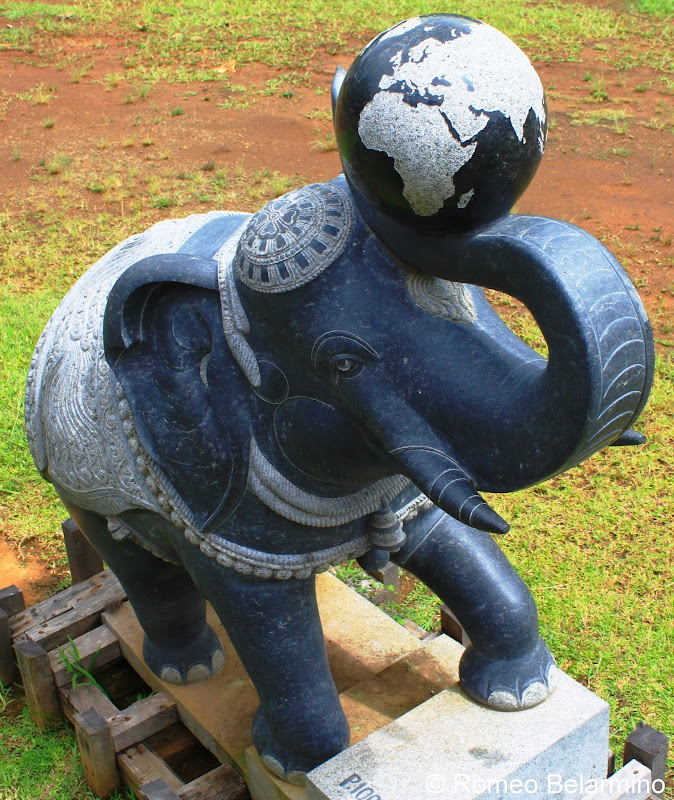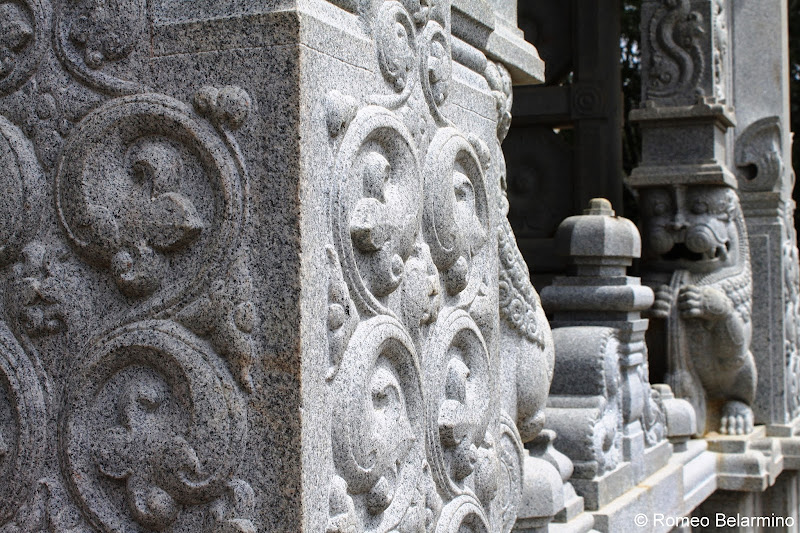 |
| A temple in progress. |
When thinking of things to do in Kauai, visiting a Hindu monastery is probably not the first thing that comes to mind. Many visitors to Kauai don’t even know the monastery exists. I think the unusualness is what appealed to me when I first learned about the monastery. We visited nine years ago on the recommendation of a friend and found it fascinating. The experience intrigued me so much I was drawn to visit another Hindu temple, the BAPS Shri Swaminarayan Mandir in Chino Hills. Kauai’s Hindu Monastery is a work in progress. While there is a small temple and monastery already on the grounds, a much larger temple is being built, which they've been working on for years. On our recent trip to Hawaii we visited Kauai’s Hindu Monastery again to check on the progress of the construction of the Iraivan Temple.
 |
| A peek into the interior of the Iraivan Temple. |
You don’t have to be a Hindu to visit the monastery and they don’t try to convert visitors. Hindus believe there are many paths to one truth. What a visit to the monastery involves is learning about its history, touring the lush grounds, and witnessing the various stages of construction of a hand carved temple.
Kauai’s Hindu Monastery was founded by Satguru Sivaya Subramuniyaswami, or Gurudeva for short. Usually when someone becomes a swami, or master, it is viewed as the beginning of life, they renunciate their previous life, and their past is forgotten. However, Gurudeva’s history is known and recorded. He was born as Robert Hansen in California in 1927. He had his first epiphany one day as a child driving home in the car. He was worried his family wasn’t going to get home in time for him to listen to Captain Marvel on the radio. But then he stopped and realized that he was worrying about something that hadn’t even happened yet, and at that moment in time he was okay. This was a lesson to not worry about what could happen, but to live in the present.
Gurudeva’s parents died when he was young and he was raised by dancers. He was trained in dance and yoga and became the principal dancer of the San Francisco Ballet Company. After World War II he traveled to Sri Lanka to find a guru. While in Sri Lanka he was initiated by Yogaswami. Gurudeva returned to the United States and started the first Hindu temple in San Francisco in 1957. He was instrumental in getting the United States to recognize the Hindu religion.
In 1968 Gurudeva visited Kauai and stayed at the Tropical Inn, which was located on the property that is now Kauai’s Hindu Monastery. He returned to Kauai in 1970, but this time stayed in Poipu. He got it into his head that he needed to build a temple and monastery on the property where he had stayed before, so he sent a monk all the way to the Tropical Inn to ask the owners if they would sell. The Tropical Inn was family-owned and the family did not want to sell. The next day Gurudeva sent the monk back to the Tropical Inn, this time to ask the family how much it would take to get them to sell. The monk came back with the answer, $575,000. Gurudeva sent the monk all the way back to the Torpical Inn on day three, this time to offer $350,000 for the property. Gurudeva’s persistence paid off, and now the property along the Wailua River is home to Kauai’s Hindu Monastery.
 |
| Views from the Pali Lookout. |
There are two ways to visit Kauai’s Hindu Monastery. The first is by self-guided tour, but you can only go so far unaccompanied. On a self-guided tour you can burn your problems in the Pua Kenikeni Mandapa urn, sound the bell next to Ganesha for a blessing, wander the path through the giant banyan tree, view the Wailua River from the Pali Lookout, and enter the Kadavul Temple for worship or meditation.
However, once a week a guided tour is offered, and this tour passes the Kadavul Temple through the botanical gardens to the area where the Iraivan Temple is being built. When we visited the monastery nine years ago, we were led by the monk who was in charge of all the plants on the property. In addition to talking about the history of the monastery, Gurudeva, and the building of the temple, he shared a lot with us about the various types of vegetation. On our visit nine years later we were led by a Hindu man who also works with the plants, but his focus was more on Gurudeva’s history as he had known Gurudeva for a few decades. Not only did we get to see the progress of the building of the Iraivan temple over nine years, we were also able to learn from a different perspective.
|
|
The Iraivan Temple is at the back of the property and was started in 1990. The foundation is made of a special Roman-inspired concrete that contains no steel and is formulated to last generations. The temple is constructed of carved granite, most of which has been carved in India, but is assembled on the grounds by stone craftsmen from India on work visas who complete the carving process on site. Some of the stones take years to carve. There are chains six feet long carved entirely from one stone. There are black granite statues and carved stones in packing crates waiting to be assembled. The temple has doubled in size in the past nine years, but much is yet to be done. The temple is slated to be completed sometime after 2017.
While not the usual Hawaiian vacation activity, visiting Kauai’s Hindu Monastery is an interesting addition to a Kauai itinerary. You’ll learn a little about the Hindu religion, stroll through a beautiful, lush garden, and witness the construction of a hand carved temple.
Guided tours of Kauai’s Hindu Monastery are offered approximately once a week starting at 9:00 a.m. and last for about 90 minutes. The tour is free, but reservations are required to reserve a parking spot. Call the monastery for tour dates and reservations. Modest clothing is required, which means no shorts, short dresses, t-shirts, or tank tops. Sarongs are available. The phone number and other visitor information can be found on their website.








